


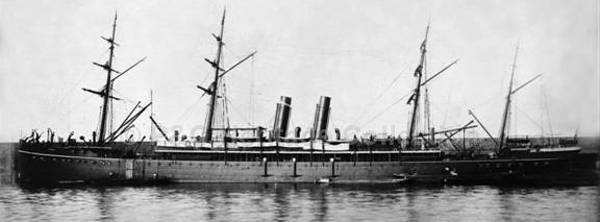
Built by Caird and Company of Greenock, and launched on 14th May 1881, Rome and her sister ship Carthage were the first P&O ships to accommodate second class passengers aft and the first class amidships.
For fourteen years, she was engaged on P&O's regular mail runs to India and Australia.
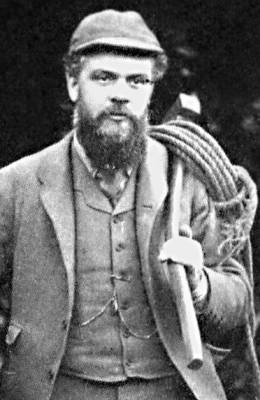
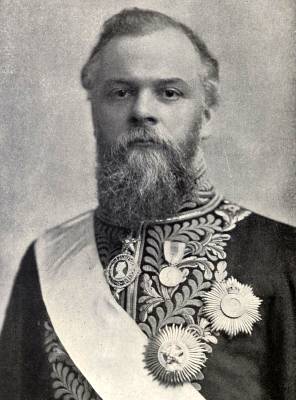
In 1894, she carried Lord Elgin out to India to take up the role of Viceroy - not a particularly notable one. He did not enjoy the pomp and ceremony associated with the viceroyalty, and his conservative instincts were not well suited to a time of economic and social unrest. He said, "India is the pivot of our Empire.... If the Empire loses any other part of its Dominion we can survive, but if we lose India, the sun of our Empire will have set."
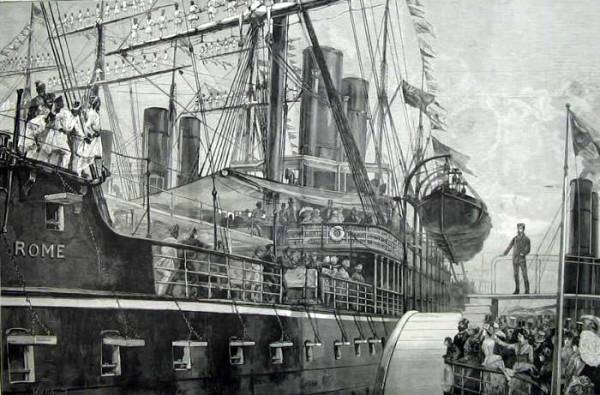
Rome departing Tilbury in 1886, from The Illustrated London News.

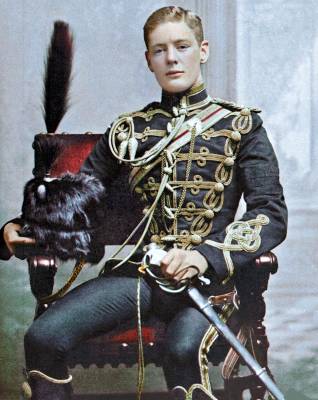
"I was on the lawns of Goodwood in lovely weather and winning my money, when the revolt of the Pathan tribesmen on the Indian frontier began. I read in the newspapers that a Field Force of three brigades had been formed, and that at the head of it stood Sir Bindon Blood. Forthwith I telegraphed reminding him of his promise, and took the train for Brindisi to catch the Indian Mail.....
I only just caught the train; but I caught it in the best of spirits......'
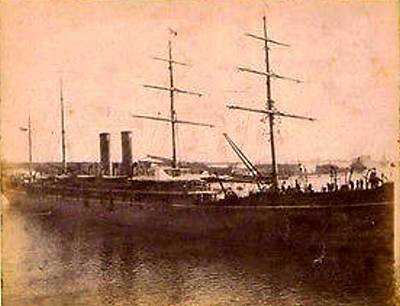
The ss Rome at Brindisi
Winston Churchill was a prolific writer. In 1953 he received the Nobel Prize in Literature for his numerous published works,
While travelling to Bombay on board the ss Rome, he wrote loving letters home to his Mother, Jennie, Lady Randolph Churchill
'My dear Mama, we are just in the hottest part of the Red Sea. The temperature is something like over 100 degrees and as it is damp hot - it is equal to a great deal more. Several people who have been about 20 years in India tell me that they have never known such heat. It is like being in a vapour bath. The whole sea is steamy and there is not a breath of air - by night or day. Under these circumstances you will not mind my writing somewhat shortly......With best love and - (no it is too hot) I remain your liquefied - evaporating but devoted son,
Winston S Churchill 7th August 1897, Steamship Rome, near Aden'
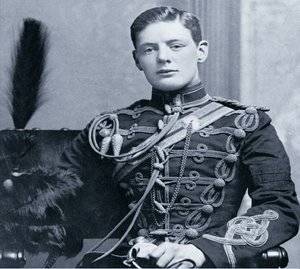
Subaltern Winston Churchill, Fourth Hussars
.....when I joined the 4th Hussars in January 1895 scarcely a captain, hardly ever a subaltern, could be found throughout Her Majesty's forces who had seen even the smallest kind of war.'
Winston was already familiar with the P&O; on September 11, 1896, as a Subaltern, Winston Churchill sailed from Southampton on board P&O's ss Britannia, contracted to the government as a troopship, with fellow officers of the Fourth Hussars, bound for Bombay.
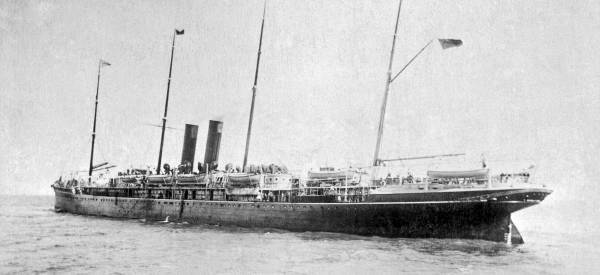
The ss Britannia of 1887
"We sailed from Southampton in a trooper carrying about 1,200 men, and after a voyage of twenty-three days cast anchor in Bombay Harbour and pulled up the curtain on what might well have been a different planet. It may be imagined how our whole ship-full of officers and men were delighted after being cooped up for nearly a month to see the palms and palaces of Bombay lying about us in a wide crescent. We gazed at them over the bulwarks across the shining and surf-ribbed waters. Every one wanted to go on shore at once and see what India was like....."
Returning home to England on leave the following year, he writes:-
I sailed from Bombay towards the end of May in sweltering heat, rough weather and fearful seasickness. When I sat up again, we were two-thirds across the Indian Ocean...'
A year later, on board the Rome, writing in My Early Life, he observed:-
'One voyage to India is enough; the others are merely repletion. It was the hottest season of the year, and the Red Sea was stifling. The hand-pulled punkahs, for in those days there were no electric fans, flapped vigorously to and fro in the crowded dining-saloon and agitated the hot food-smelling air.
Disembarking from the Rome at Bombay, Winston travelled on to Nowshera, and joined the Malakand Field Force, on the front line, commanded by General Sir Bindon Blood. On one occasion, after several officers fell in battle, Winston commanded a company of Punjab infantry.
His commanding officers lauded his courage and bravery in what was a violent and exceedingly savage campaign.
'When you're wounded and left on Afghanistan's plains, and the women come out to cut up what remains, jest roll to your rifle and blow out your brains and go to your gawd like a soldier.' Rudyard Kipling
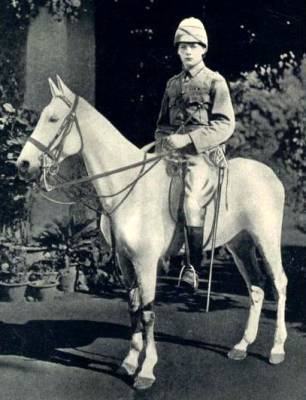
Returning to Bangalore and garrison duty, Winston used the time to write his first book, The Story of the Malakand Field Force, which was published to wide acclaim in 1898.

The shadow falls along the shore
The search lights twinkle on the sea
The silence of a mighty fleet
Portends the tumult yet to be.
The tables of the evening meal
Are spread amid the great machines
And thus with pride the question runs
Among the sailors and marines
Breathes there the man who fears to die
For England, Home, & Wai-hai-wai......
Note: Wai-hai-wai is a reference to Weihai in China. This is the only poem in Churchill’s handwriting as an adult. There is one at Harrow School but he wrote it as a boy, for a competition.
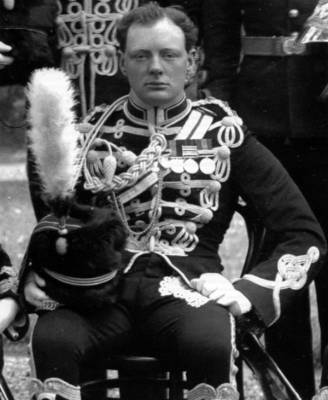
In 1904, the Rome was converted to a Cruising Yacht, and re-named Vectis....

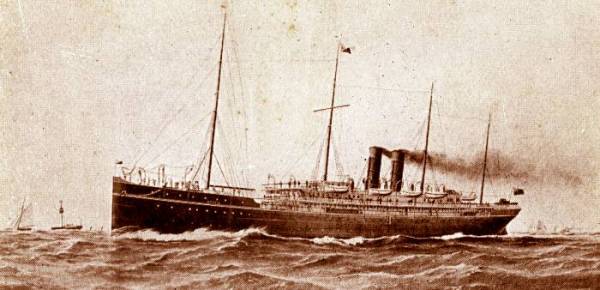
'Vectis of 6,000 tons and 6,000 horsepower has been specially fitted as a yacht to carry 150 passengers, and will be regularly employed on the Pleasure Cruises which have become popular in combining the most delightful Holiday Excursions, with the benefit of sea air, under the most luxurious conditions. No expense has been spared in adapting the Vectis for this purpose, and her cabin accommodation, Saloons, Card, Recreation, Smoking and Photographic Rooms will be found equal in all respects to what they should be for the work in which the ship will be engaged.....'
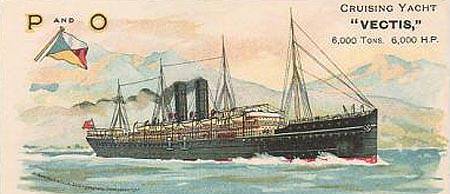
At first, it was very much for the upper classes, People were interested in sailing for pleasure, but you had to have money and time to spare. P&O’s first cruise ship, Vectis, entered service in 1904, and after cruising was recommended in the British Medical Journal for its health benefits, thousands of people signed up to see the world.
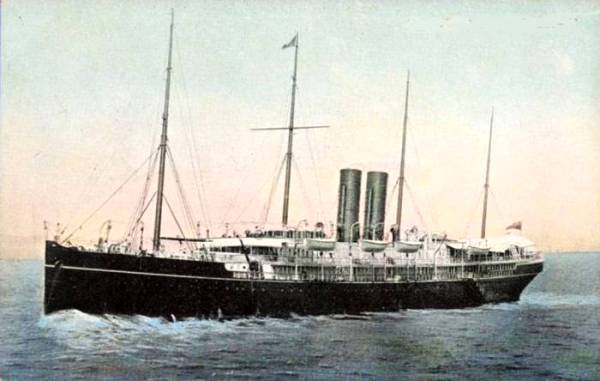
Renamed and extensively
refitted, the
stylish Cruising Yacht Vectis carried 150 passengers in first class accommodation, on cruises to
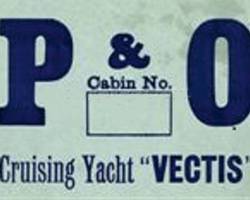
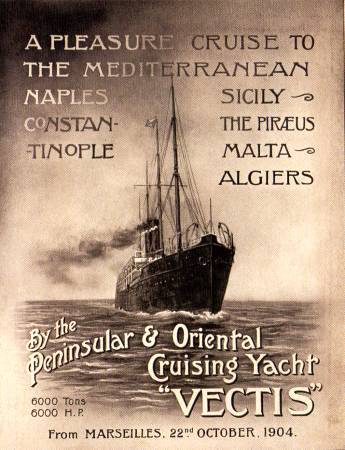
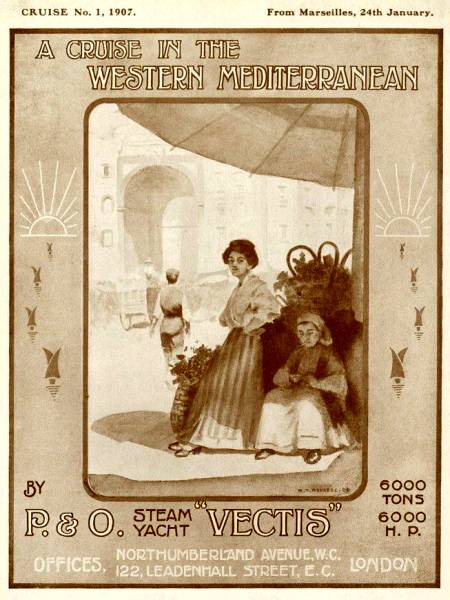

Encouraged by her success, she was joined by the ss Malwa for cruises throughout the Mediterranean during the summer months.
By 1909, Vectis and Malwa were well established.....
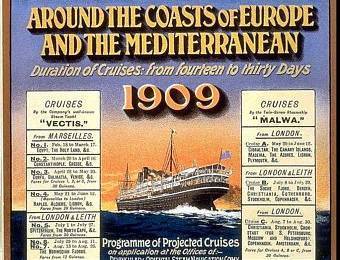
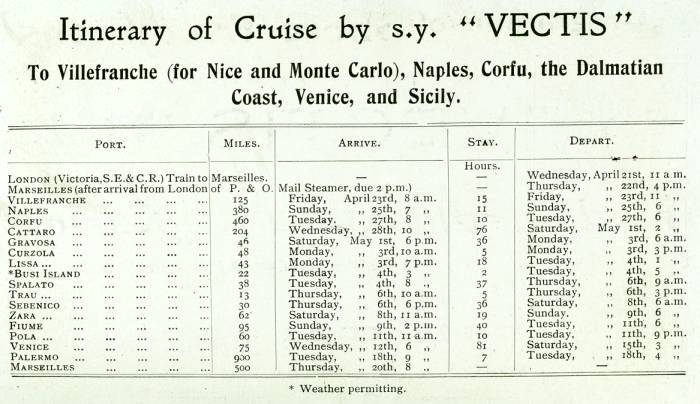
A comprehensive 1909 Itinerary, National Maritime Museum Archive
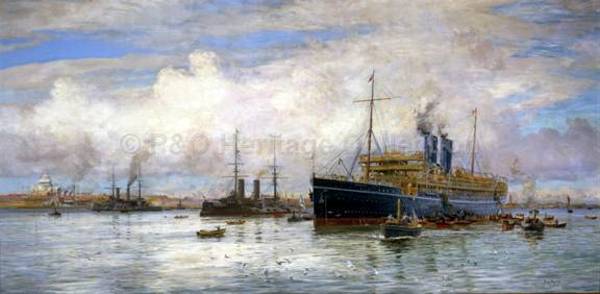
Malwa at the Russian port of Kronstadt, Saint Petersburg's main seaport. in 1909, when Russian naval officers were entertained on board. Painting by William Lionel Wyllie, P&O Heritage.
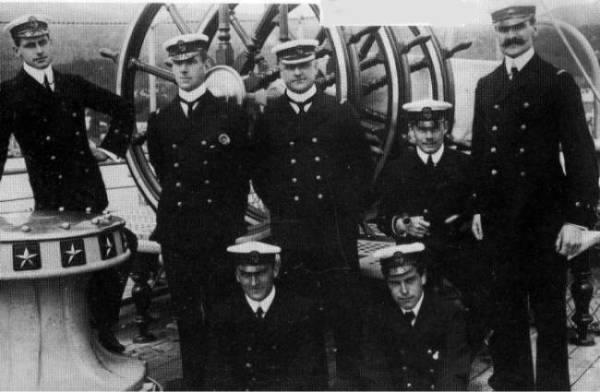
Vectis's hand-picked deck officers wore Royal Navy style frock coats, with eight gold buttons, distinctive P&O cap badges and the Company's rank insignia. The ship's Commander, Captain Thompson is at the centre of the photograph, while the moustachioed officer on the right is the ship's Purser.
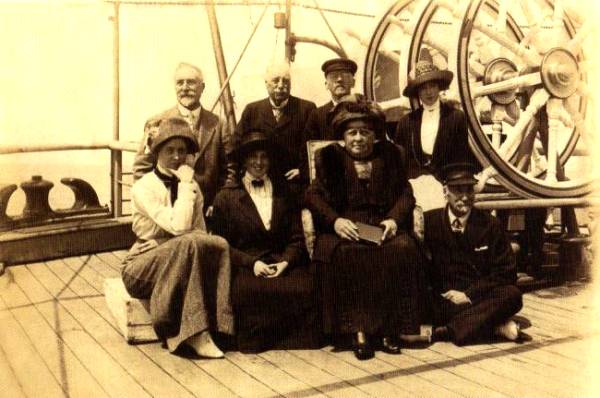
Meanwhile, passengers strike a rather stolid pose for a group portrait on board the Cruising Yacht Vectis.
'....there are beautiful drawing and lounge rooms, the finest smoking room we have ever seen, the dining room is splendidly situated and the meals are excellent and well served, the steward in charge, Mr Dust, the most courteous of officials we have had the pleasure of meeting, the cabins are light and well ventilated and the beds most comfortable; our cabins being No 78 and 79, our neighbour, the barber Mr Sales, who is most obliging and intelligent; it was a pleasure to be shaved by him, and his shop is the largest we have ever seen on any ship. There are three dark rooms for photographers which I have found most useful. The promenade deck is very spacious, eight trips round it the mile. This splendid ship carries a crew of 196 and has accommodation for 183 passengers and a coaling capacity of 1,800 tons. Wrttent by Edward Rawdin, a seasoned passenger who completed three cruises aboard the Vectis..
Among Vectis's passengers on her inaugural cruise were the acclaimed marine artist William Lionel Wyllie and his wife Marion.
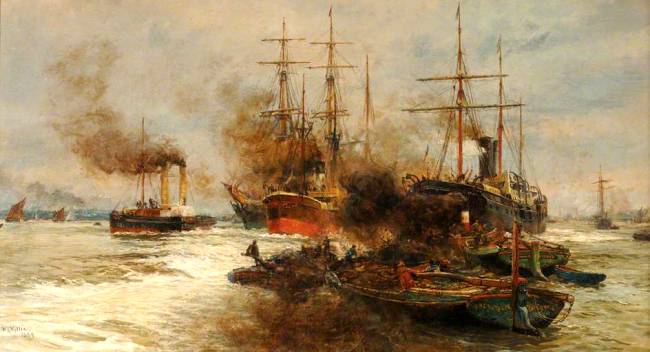
Together with 148 fellow passengers, they boarded Vectis in the London River.
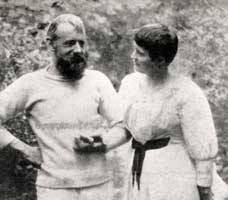
William Lionel Wyllie married Marion Amy Carew in 1879, and between 1880 and 1904 she bore him nine children. Tragically, two Sons, Bill and Robert, were killed in the First World War.
A prolific painter, William was working right up until his death in 1931, aged 79.
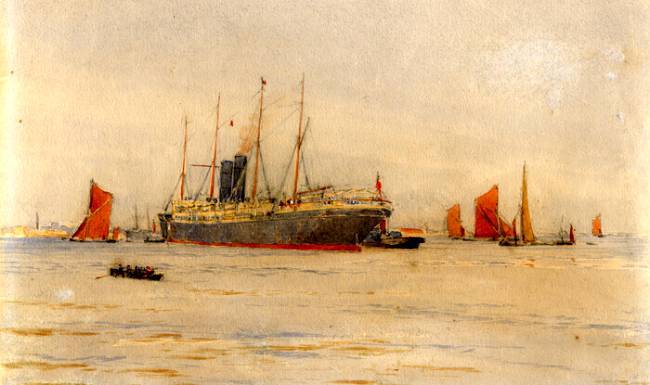
On a personal note, I have long admired the work of William Lionel Wyllie (1851-1931) and regard him as one of Britain's premier marine artists of the later Victorian and early 20th century. Highly proficient as a painter in both oil and watercolour, he is also known for highly atmospheric etchings of vessels, big and small, in the many harbours and waterways around the British Isles and beyond. He was an enthusiastic student of the sea and a keen sailor, a passion reflected in the accuracy with which he depicted the various vessels in his work, be they long retired men-of-war from the age of Nelson, Thames barges, J-class yachts, the warships of Jellicoe's Grand Fleet or the stately passenger ships of the P&O. Wyllie exhibited regularly at the Royal Academy and Royal Institute throughout his life. Nick Messinger
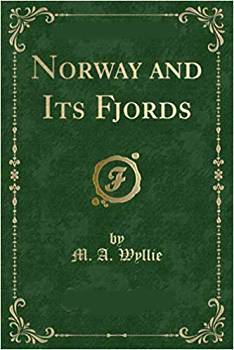
William Wyllie joined the ship for her inaugural cruise to Norway, Spitzbergen and the North Cape, accompanied by his wife Marion, who researched and wrote Norway & Its Fjords, which was published by Methuen & Co of London in 1907.
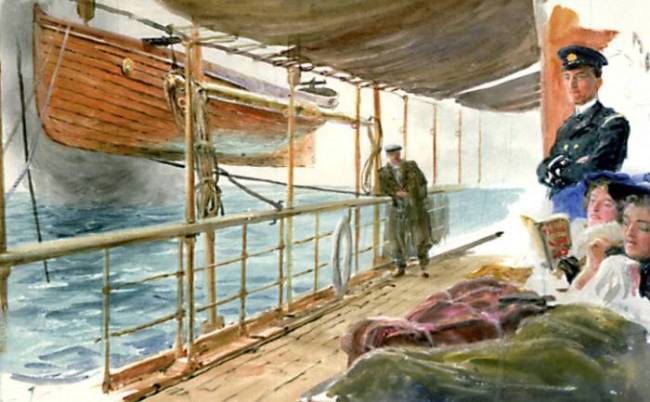
........they lay drowsily extended in various positions of comfort on their chairs on the broad white after-deck, the happy moment after lunch; too soon to get to work or play, the tremor of the great screw acting as the mother's foot on the cradle rocker.
From: Norway and its Fjords by Marion A. Wyllie. With sixteen illustrations in colour, by William Lionel Wyllie, RA.
William Wyllie’s formal art education began in 1865 at the Heatherley School of Fine Art on Newman Street in London, where he concentrated on making drawings from antiques, as he was too young to attend the life drawing classes.
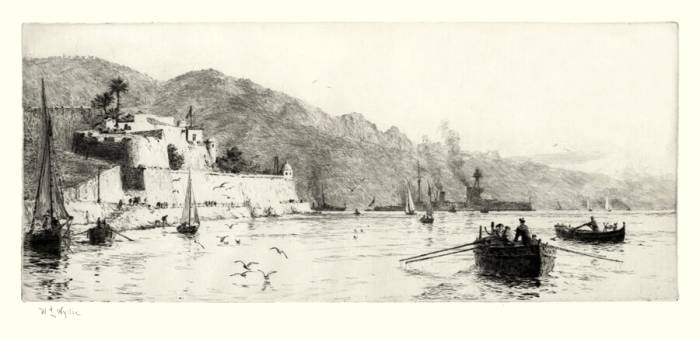
His etchings display a deftness of touch and a rare ability to capture brilliantly the flickering of light upon moving water, as in the example above, entitled Villefranche. He worked the copper plates himself and utilised the techniques of the master etcher - creating deeply-bitten blacks, deploying drypoint to add spontaneity and aquatint to provide tone. Remarkably, Wyllie won the Turner Gold Medal at the age of eighteen and later earned full membership of the Royal Academy, The Royal Institute of Painters in Watercolours, The Royal Society of Painter-Etchers and Engravers, amongst other accolades.
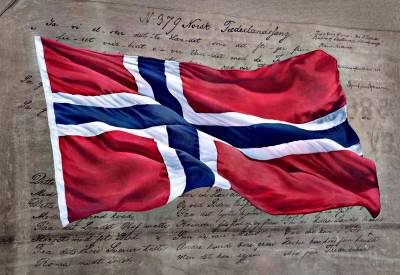
'Our ship steams steadily on, and it would seem as though there is no end to the labyrinth of ice-worn rocky islets...' Marion Wyllie, Norway and its Fjords.
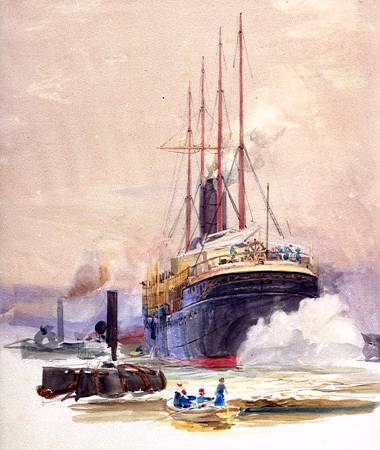
Vectis at Kristiania - William Lionel Wyllie
Originally called Christiania, from 1877 the name was spelled Kristiania, and in 1925 was changed back to the city's original name, Oslo.
'The ship is still plunging through the waves, and now the passengers, who still brave the elements, have dwindled to a very small party. The island of Karmo comes in sight on the starboard bow, and all sorts of jagged rocks go by as we plunge northward. A long journey outside the skjaergaard is not a pleasant prospect in weather like this, but all at once we notice that our wake is not right astern , but trends away to the starboard quarter.....'
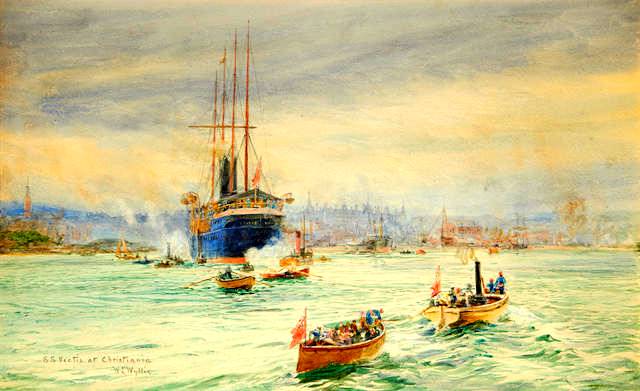
Vectis at Kristiania
'It is clear that kind-hearted Captain Thompson has made up his mind to take us up inside the islands.
The sight of many pale faces, and all those empty chairs, has moved him to take the longer, and to him, no doubt, more troublesome route. Soon, we are under the lee of Skudesnas, and one by one limp, red-eyed bodies, with hair out of curl and rumpled clothes, make their appearance, blessing the skjaergaard and good Captain Thompson.'
Much of the coast of Norway is penetrated by fjords and fringed by countless islands, islets, rocks and reefs, known as the skjaergaard - a Norwegian word, literally meaning a rock rampart.
At Recherche Bay, Spitsbergen they heard loud bangs as if a gun was fired, when large pieces of beautiful green ice drifted by, colliding against each other. One piece came very close and actually grazed the side of the ship making a sound like a tin can struck by a hammer, as one excited passenger noted in her diary.
The first cast of the lead was forty-five fathoms, the second forty-two. Thump! Thump! Thump! went the propeller as the engines reversed , and a great seething mass of foam burst out from under the counter, and washed slowly forward as the ship lost her way. Thump!Thump! Thump! and the after end of the Vectis is the centre of a perfect vortex of fierce little waves, which breaking off in ever widening circles dimple the surface of the dark green fjord.
"She's going astern, Sir," sings the leadsman.
"Let go," says a voice from the bridge.
There is a tremendous splash , and the chain rushes madly out through the hawsepipe with a harsh grating roar, whilst a thick mist of iron rust and powdered paint rises into the air, through which the Lascars on the forecastle are dimly seen, like phantoms tending the whirring cable as it leaps up from the depths of the chain locker. Shackle after shackle goes plunging down overboard, and the brown cloud covers the whole fore of the ship, coating everything in dust.....'
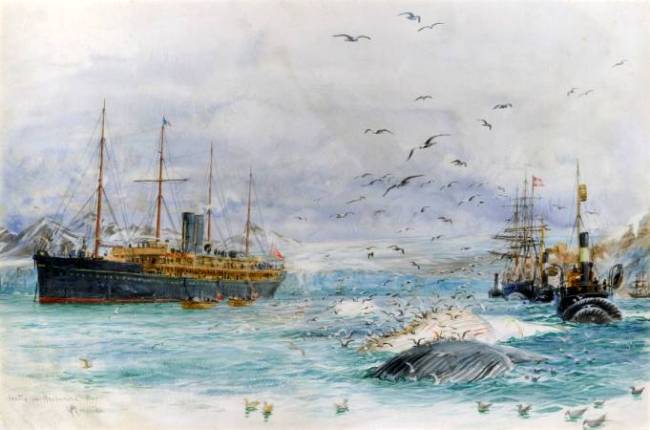
Vectis anchored in Recherche Bay on the west coast of Spitsbergen.
'Wherever the Vectis steamed, the Ile de France had just left. Her name in giant letters of white was painted on the cliffs of the Naero Fjord. In Recherche Bay we enquired of the sailors on board the whalers, Had the Ile de France been there? Had the passengers shot any bears? 'Yes' was the answer to the first question; 'No' to the second. Had they caught any foxes? 'No'.
It was not the season for the one or the other.
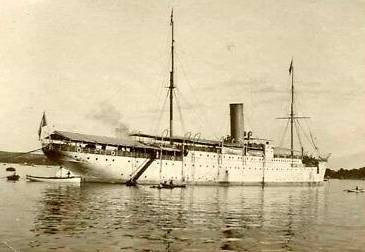
French Tourist Steamer Ile de France
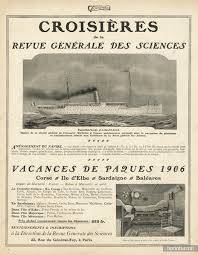
"Chasseresses ou non" huntsmen or not, the Ile de France's lavish brochure had pictured polar bears and a variety of hunts, with the prey consisting of whales, reindeer, au lagopede des Neiges, aux petits echassiers et au grands palimpedes de l'ocean boreal - eider, bernache goose, arctic petrels, pigeons, cormorants, the scarce blue fox, and great seals of the ice-pack.
Activities unsuited to the more genteel passengers of the Cruising Yacht Vectis I would suggest.....À chacun ses goûts...
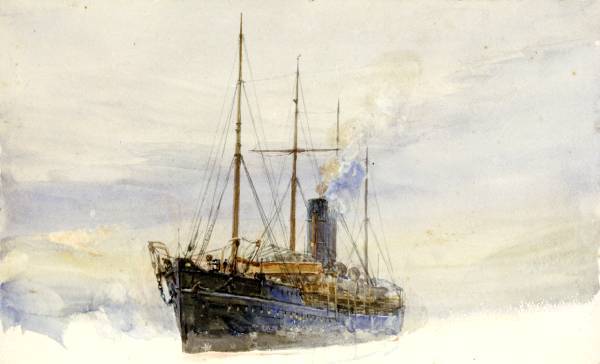
After a number of shore visits and parties on board, the trip was nearing the end. During their time away, William had been busy sketching and painting and was urged by friends and fellow passengers to display his work. The captain allowed him to organise a small exhibition in the music room. There ensued a scramble to acquire some of these beautiful reminiscent pieces of art, representing a memorable trip. The Wyllies had to ask the purser to store the large sum of money from the proceeds of the successful sale in the safe. It was with great satisfaction when the couple arrived back home, rested and in good health .. and in pocket
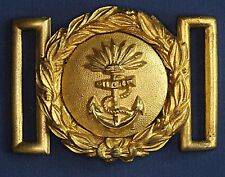
In October 1912, Vectis was sold for £11,040 to the French Government, who proposed to convert her to a hospital ship, but in 1913, she was sold to Italian shipbreakers.